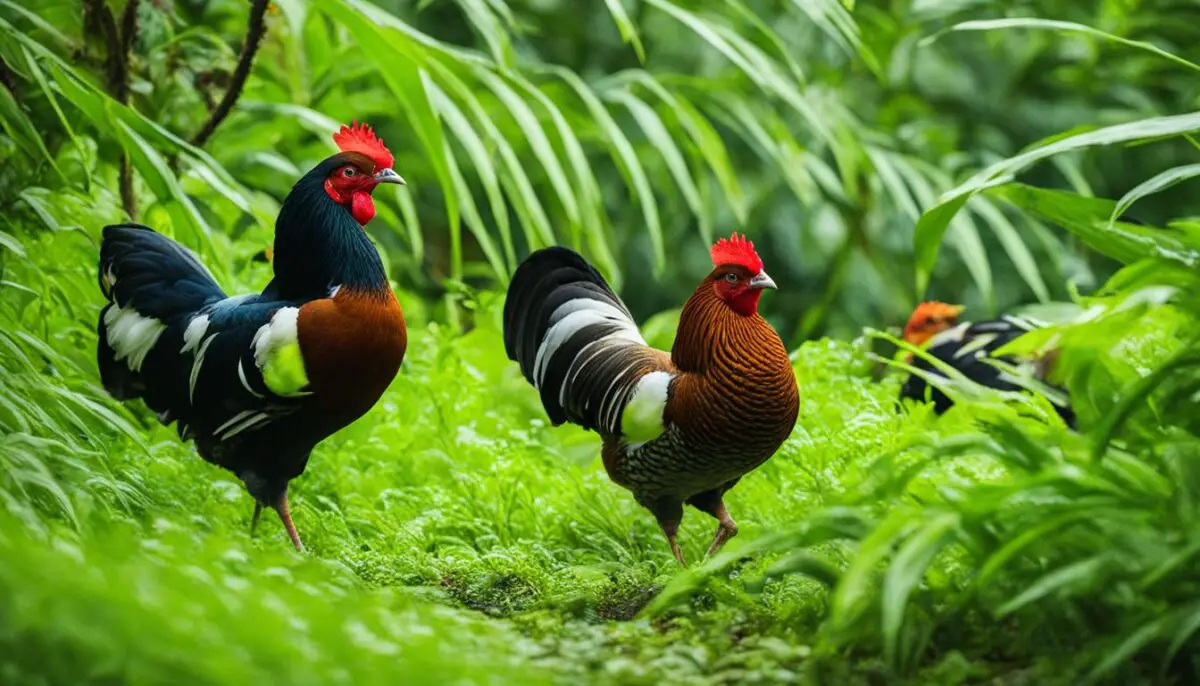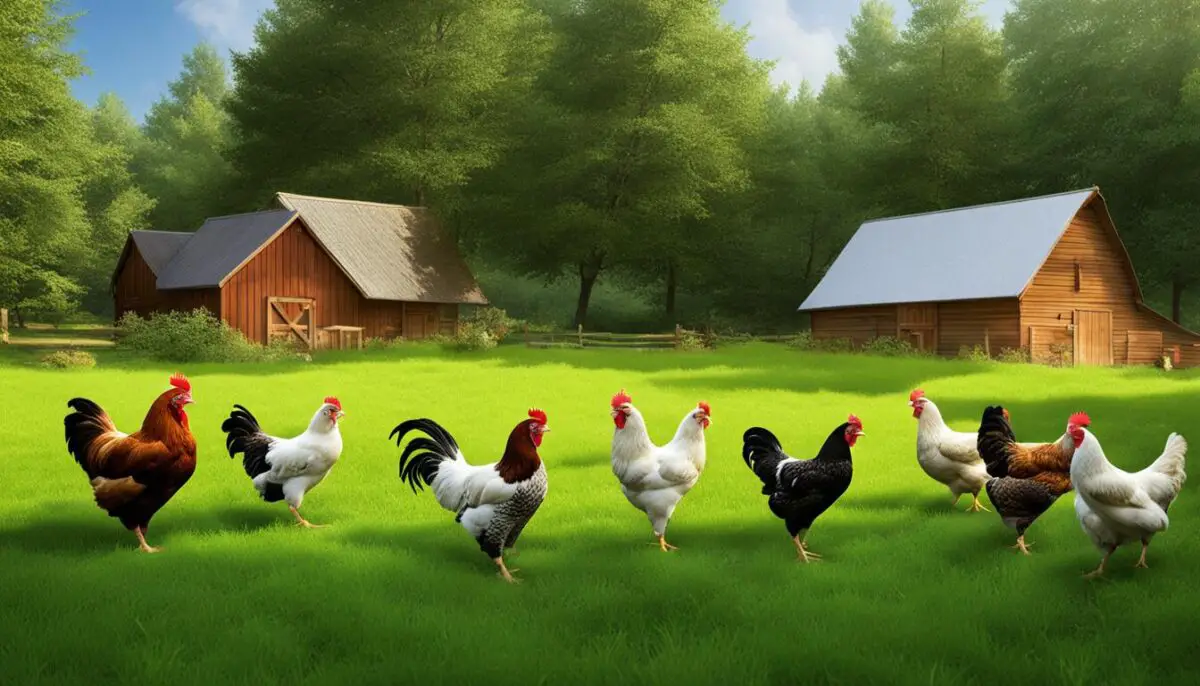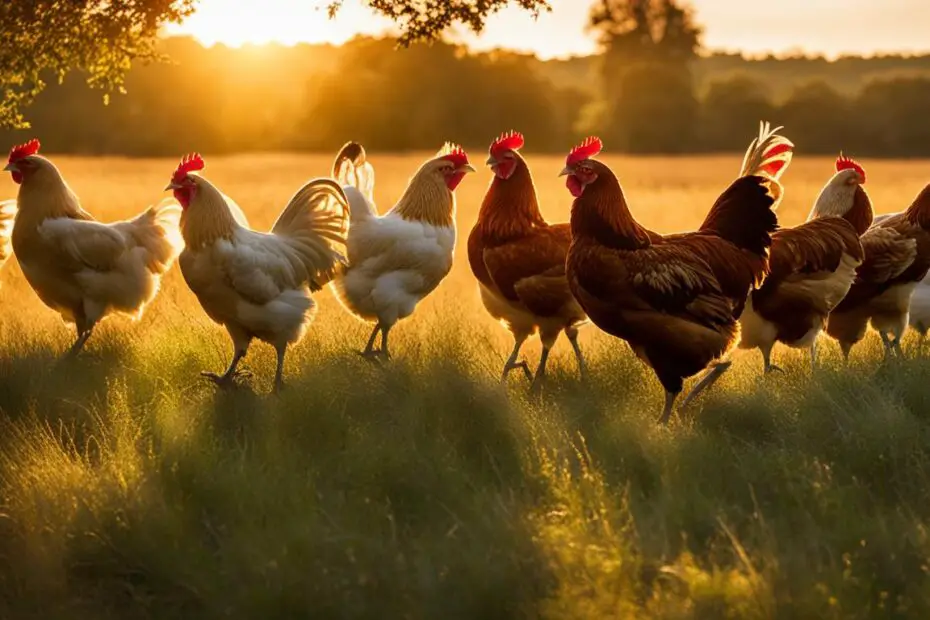Welcome to our insightful guide on understanding how far free range chickens will roam and their behavior in a natural environment. It’s fascinating to explore the factors that influence their roaming distance and how we can create an optimal environment to support their natural instincts. Whether you’re a chicken owner or simply curious about these feathered friends, this guide will provide valuable insights into their roaming habits and how to strike a balance between freedom and safety for these curious creatures.
Key Takeaways:
- Factors such as breed, food, water, and climate influence how far chickens will roam.
- Understanding the natural roaming instincts of chickens helps in creating an optimal chicken roaming area.
- Wild jungle fowl, the ancestors of domesticated chickens, exhibit particular habits of roaming, influencing the behavior of domestic chickens.
- Chickens possess a homing instinct that guides them back to their coop or designated area.
- Different breeds of chickens exhibit varying roaming behaviors, influenced by breed-specific characteristics.
Factors that Determine the Roaming Distance
Understanding the factors that determine the roaming distance of free-range chickens is essential for creating an environment that supports their natural behavior. Several influences impact how far chickens will roam, including their natural instinct, breed differences, food and water availability, and climate and weather conditions.
Chickens have an instinct to roam inherited from their wild jungle fowl ancestors. This instinct drives them to explore their surroundings in search of diverse food sources and to escape potential threats. Different breeds of chickens exhibit varying roaming behaviors, with some breeds naturally inclined to venture further than others.
The availability of food and water also plays a role in a chicken’s desire to roam. When resources are limited, chickens may feel compelled to wander further in search of sustenance. Conversely, when food and water are readily available within their immediate surroundings, chickens may have a smaller roaming radius.
“Chickens have an instinct to roam inherited from their wild jungle fowl ancestors.”
Climate and weather conditions can also impact a chicken’s roaming behavior. Extreme temperatures or inclement weather may cause chickens to stay closer to their coop for safety. On the other hand, mild weather conditions may encourage chickens to explore their surroundings more freely. It’s important to consider these factors when creating a balanced environment for free-range chickens, ensuring their safety while still allowing them to engage in their natural behavior.
| Factors Affecting Roaming Distance | Impact on Roaming Behavior |
|---|---|
| Natural instinct | Drives chickens to roam and explore their surroundings |
| Breed differences | Varying roaming behaviors among different breeds |
| Food and water availability | Affects a chicken’s desire to roam |
| Climate and weather conditions | Influences the extent of roaming behavior |
The Natural Instinct of Chickens
Chickens have a natural instinct to roam, which is inherited from their wild jungle fowl ancestors. This roaming instinct serves a vital purpose in their survival, helping them find diverse food sources and escape potential threats. Understanding this natural instinct is essential for creating an optimal chicken roaming area.
To effectively manage chicken roaming behavior, it is crucial to set boundaries and install barriers. These measures help create a controlled environment that balances the benefits of free-ranging chickens with the need for safety and control. Additionally, chickens have a homing instinct that guides them back to their coop or designated area, ensuring their security while they explore their surroundings.
By providing an adequate roaming area and incorporating boundary management techniques, chicken owners can support their flock’s natural instincts while maintaining their safety. This allows chickens to engage in natural behaviors such as foraging, exercise, and socialization, promoting their overall well-being.
Benefits of Understanding Free Range Chicken Movement:
- Enables the creation of an optimal chicken roaming area
- Promotes natural behaviors like foraging and exercise
- Enhances chicken well-being and overall health
- Supports socialization among the flock
- Provides opportunities for diverse food sources
“Understanding the natural roaming behaviors of chickens is key to creating an environment that supports their instinctual needs while ensuring their safety and security.”
| Factors Influencing Chicken Roaming Behavior | Impact on Roaming Behavior |
|---|---|
| Food and Water Availability | Affects desire to roam; limited availability may lead to further exploration |
| Climate and Weather Conditions | Influences roaming behavior; extreme temperatures or bad weather may keep chickens closer to the coop |
| Breed Differences | Each breed exhibits varying roaming behaviors based on their genetic predispositions |
The Roaming Habits of Wild Jungle Fowl
Wild jungle fowl, the ancestors of domesticated chickens, exhibit unique roaming habits that influence the behavior of their domestic counterparts. These wild birds have an innate instinct for exploration, covering large distances in search of food and suitable habitats. While the roaming distance of domestic chickens can vary based on factors such as breed, food availability, and climate, their roaming habits are still influenced by the traits inherited from their wild ancestors.
Understanding the roaming habits of wild jungle fowl provides valuable insights into creating a controlled environment for free-range chickens. By replicating the natural roaming habits of these ancient birds, chicken owners can ensure that their flock has enough space to satisfy their instinctual need to explore while maintaining safety and security.
To create an optimal environment that supports natural roaming habits, chicken owners should consider factors such as breed-specific characteristics, space in the coop and run, and safety measures. By designing a controlled space with enough room for chickens to roam freely, owners can provide a balanced environment that allows for natural foraging, exercise, and socialization while minimizing the risks associated with unrestricted roaming.

Breed-Specific Roaming Behaviors
“Different breeds of chickens exhibit varying roaming behaviors.”
Various chicken breeds have distinct roaming behaviors influenced by their genetic makeup and breed-specific characteristics. For example, some breeds are more inclined to roam farther distances, while others may prefer to stay closer to their coop. Understanding the roaming behavior of specific breeds enables chicken owners to create an environment that caters to their flock’s specific needs.
| Breed | Roaming Behavior |
|---|---|
| Rhode Island Red | Medium roaming distance |
| Leghorn | Long roaming distance |
| Silkies | Short roaming distance |
By understanding the breed-specific roaming behaviors, chicken owners can tailor their coop and run design to accommodate the natural inclinations of their flock, providing an optimal environment for roaming while ensuring the safety and well-being of the chickens.
The Homing Instinct of Chickens
Chickens possess a remarkable homing instinct that enables them to find their way back to their coop or designated area. This instinct ensures their safety and security while they roam within a certain radius in search of food, water, and shelter. Regardless of breed, chickens are equipped with the ability to navigate their surroundings and return to familiar territory.
Factors such as breed, food, water, and climate can influence a chicken’s roaming behavior, but ultimately, their homing instinct guides them back home. This instinct is deeply ingrained in their DNA, inherited from their ancestors who relied on it for survival.
To maximize the benefits of the homing instinct and create an optimal chicken roaming area, it is essential to provide an environment that supports their natural behaviors. This includes establishing boundaries, installing barriers, and training chickens to return to the coop. Additionally, using calling techniques and feeding cues can help reinforce the homing instinct and encourage chickens to come back to the desired area.
Table: The Homing Instinct of Different Chicken Breeds
| Chicken Breed | Homing Distance (Approximate) |
|---|---|
| Rhode Island Red | 500-1000 feet |
| Ameraucana | 800-1200 feet |
| Leghorn | 1000-1500 feet |
| Orpington | 1500-2000 feet |
The homing instinct varies slightly among different chicken breeds. While some breeds may have a smaller roaming radius, others have a predisposition to explore a larger area before returning home. Understanding the homing distance of different breeds can help chicken owners plan their roaming areas accordingly.
By leveraging the homing instinct of chickens and providing an optimal roaming area, chicken owners can ensure the safety, well-being, and enjoyment of their free-range flock.
How Different Breeds of Chickens Roam
Different breeds of chickens exhibit varying roaming behaviors. Understanding these behaviors can help chicken owners create an environment that supports their natural instincts while ensuring their safety. By providing enough space in the coop and run, as well as implementing strategies to manage roaming behavior, owners can maximize the benefits of free-ranging chickens.
Wild jungle fowl, the ancestors of domestic chickens, provide insight into the range of behaviors exhibited by different breeds. These wild fowl exhibit an instinct for exploration and can cover large distances in search of food and habitats. Domestic chickens still retain some of these innate instincts, but breed-specific characteristics can also influence their roaming behavior.
To replicate the natural roaming habits of wild jungle fowl, it is important to design the coop and run with enough space for chickens to roam and engage in natural activities. This includes providing multiple levels, perches at varied heights, and stimulating elements like toys and treat dispensers. Managing roaming behavior involves establishing boundaries, training chickens to return to the coop, and using calling techniques and feeding cues. These techniques balance the benefits of free-ranging, such as exercise, natural foraging, and socialization, with the need for safety and control.
| Breed | Roaming Behavior |
|---|---|
| Plymouth Rock | Moderate roaming distance |
| Rhode Island Red | Medium roaming distance |
| Leghorn | Extensive roaming distance |
Different breeds of chickens have different roaming behaviors. For example, Plymouth Rock chickens have a moderate roaming distance, while Rhode Island Reds have a medium distance. Leghorns, on the other hand, have an extensive roaming distance. These differences should be considered when designing the coop and run and determining the appropriate roaming area for each breed.
Key Takeaways:
- Different breeds of chickens exhibit varying roaming behaviors.
- Wild jungle fowl, the ancestors of domestic chickens, provide insight into breed-specific roaming characteristics.
- Designing the coop and run with enough space and stimulating elements supports natural chicken behaviors.
- Managing roaming behavior involves establishing boundaries, training, and using calling techniques.
- Consider breed-specific roaming distances when designing the coop and run.
The Relationship Between Roaming Distance and Food/Water Availability
When it comes to free-range chickens, the amount of space they need to roam depends on various factors. One of the key factors that can influence their roaming distance is the availability of food and water. Chickens tend to roam further when their food and water sources are limited. This is because they need to explore a larger area in search of sustenance.
However, it’s important to note that the breed of chickens, climate, weather conditions, and other factors also play a role in their roaming behavior. Providing enough space in the coop and run, along with ensuring adequate access to food and water, can help reduce the need for chickens to venture too far away. By creating a balanced environment, chicken owners can promote healthy roaming behaviors while still maintaining control and safety.
“Chickens tend to roam further when food and water are limited.”
Designing the coop and run with the specific needs of roaming chickens in mind can also contribute to their overall well-being. It’s essential to consider their natural instincts and behaviors when setting up the space. By incorporating features such as multiple levels, perches at different heights, and stimulating elements like toys and treat dispensers, chicken owners can create an optimal habitat that encourages natural wandering habits while ensuring safety.
| Factors Influencing Roaming Distance | Impact on Roaming Behavior |
|---|---|
| Food and water availability | Influences chickens to roam further when limited |
| Breed of chickens | Varies based on breed-specific characteristics |
| Climate and weather conditions | Extreme temperatures or bad weather may cause chickens to stay closer to their coop |
By understanding how much space free-range chickens need and the relationship between roaming distance and food/water availability, chicken owners can create an environment that supports their natural behaviors while meeting their basic needs. This allows chickens to roam freely, promoting exercise, natural foraging, and socialization while still ensuring their safety and well-being.

Climate and Weather Conditions and Their Impact on Roaming Behavior
Climate and weather conditions play a significant role in the roaming behavior of free-range chickens. These factors, along with breed, food, water, and general environmental conditions, can determine how far chickens will roam. Extreme temperatures or unfavorable weather may cause chickens to stay closer to their coop for safety and protection. Understanding and managing their roaming behavior is essential for their well-being.
A combination of hot and cold weather can pose risks to free-range chickens. In extremely hot conditions, they may seek shade and stay close to the coop to avoid heat stress. Similarly, in freezing temperatures, chickens may choose to stay near the coop to keep warm. It is crucial to provide adequate shelter and protection during such weather conditions to prevent health issues.
Establishing boundaries and barriers, training chickens to return to the coop on command, and using feeding cues can help manage the roaming behavior of free-range chickens. By providing a secure and controlled environment, chicken owners can strike a balance between the benefits of free-ranging, such as exercise and natural foraging, and the need for safety and protection. Regular assessment and updates to the coop and run design will ensure the ongoing safety and well-being of free-range chickens.
| Climate/Weather Condition | Roaming Behavior |
|---|---|
| High Temperatures | Chickens tend to stay closer to the coop to avoid heat stress. |
| Freezing Temperatures | Chickens may choose to stay near the coop to keep warm. |
“Extreme temperatures or bad weather may cause chickens to stay closer to their coop for safety.”
Providing Enough Space in the Coop and Run
Creating a spacious coop and run is crucial for ensuring the well-being of free-range chickens. The amount of space needed depends on various factors such as breed size, age, and growth. By providing adequate space, you can promote the natural roaming behavior of chickens and allow them to engage in activities that contribute to their overall health and happiness.
When designing the coop, consider incorporating multiple levels and perches at different heights. This not only provides additional space for chickens to explore but also allows them to exercise their natural instinct to roost and perch. Adding obstacles like logs and rocks in the outdoor run can provide opportunities for chickens to climb and explore, simulating their natural environment.
It’s also important to provide chickens with access to a grazing area with grasses, weeds, and bugs. This not only encourages natural foraging behavior but also ensures that they have a diverse and balanced diet. Allowing chickens to roam freely in a well-designed and spacious coop and run promotes their physical and mental well-being, leading to happier and healthier chickens.

| Factors to Consider | Space Requirement |
|---|---|
| Breed Size | Small breeds: 2-3 square feet per chicken Medium breeds: 4-5 square feet per chicken Large breeds: 6-8 square feet per chicken |
| Age and Growth | Chicks: 0.5-1 square foot per chick Pullets: 2-3 square feet per pullet Adult chickens: As per breed size |
| Outdoor Run | At least 10 square feet per chicken, but more is better |
By following these guidelines and considering the specific needs of your flock, you can provide an optimal roaming area for your free-range chickens. Remember, the more space you provide, the happier and healthier your chickens will be.
Designing the Coop and Run for Natural Behaviors
Creating the ideal environment for free-range chickens involves designing the coop and run to support their natural behaviors. By providing enough space, proper ventilation, and stimulating elements, chicken owners can ensure their flock’s safety and promote their natural wandering habits.
Optimal Coop and Run Design
The coop should have multiple levels and perches at varied heights, allowing chickens to roost and perch comfortably. Adding features like logs and rocks in the outdoor run provides opportunities for chickens to climb and explore. These design elements replicate the natural behaviors of chickens, making them feel more at home.
Furthermore, incorporating stimulating elements like toys and treat dispensers in the coop and run keeps the chickens engaged and mentally stimulated. This not only promotes their overall well-being but also encourages their natural wandering habits.
The Importance of Safety
While designing the coop and run, it is crucial to prioritize safety. Installing proper fencing and barriers ensures that chickens do not wander too far away and helps protect them from predators. Additionally, providing secure locks for doors and windows prevents unwanted access and keeps the chickens safe inside their designated area.
Regular assessment and updates to the coop and run design will help maintain a safe and conducive environment for free-ranging chickens. By considering their natural behaviors and providing them with the space and elements they need, chicken owners can create an optimal habitat where their flock can thrive.

| Coop Design | Run Design | |
|---|---|---|
| Space | The coop should have enough space for chickens to move around comfortably, with multiple levels and perches. | The run should provide ample space for chickens to roam, with stimulating elements like logs and rocks for climbing. |
| Ventilation | Proper ventilation is essential to ensure fresh airflow and prevent the buildup of ammonia and other harmful gases. | Good airflow in the run helps to maintain a healthy environment and prevent the accumulation of moisture and waste. |
| Stimulating Elements | Include features like toys and treat dispensers to keep chickens mentally stimulated and engaged. | Design the run with stimulating elements that replicate natural environments, encouraging exploration and foraging. |
| Safety Measures | Install secure locks for doors and windows to prevent unwanted access and keep chickens safe inside the coop. | Ensure proper fencing and barriers to protect chickens from predators and prevent them from wandering too far away. |
Conclusion
Understanding the factors that influence how far free-range chickens will roam is crucial for creating an environment that balances their natural instincts with safety and control. Factors such as breed, food, water, and climate play a significant role in determining their roaming behavior.
To maximize the chicken roaming area, it is essential to establish boundaries and install barriers to manage their movement effectively. Training chickens to return to the coop and using calling cues can also help in controlling their roaming behavior.
By implementing these tips, chicken owners can provide their flock with the opportunity to roam freely while ensuring their safety. This enables chickens to enjoy the benefits of exercise, natural foraging, and socialization, resulting in happier and healthier birds.
FAQ
How far will free-range chickens roam?
The roaming distance of chickens can vary depending on factors such as breed, food, water, and climate. Some chickens may roam a few yards, while others may cover larger distances.
What factors influence the roaming distance of chickens?
Several factors can influence how far chickens will roam, including breed differences, food and water availability, and climate and weather conditions.
How does the natural instinct of chickens affect their roaming behavior?
Chickens have an instinct to roam inherited from their wild jungle fowl ancestors. This roaming instinct helps them find diverse food sources and escape potential threats.
What can we learn from the roaming habits of wild jungle fowl?
Wild jungle fowl, the ancestors of domesticated chickens, exhibit particular habits of roaming. By understanding these habits, we can create a controlled environment that supports the natural roaming behavior of chickens.
Do chickens have a homing instinct?
Yes, chickens have a homing instinct that enables them to find their way back to their coop or designated area. This instinct ensures their safety and security while they roam within a certain radius.
How do different breeds of chickens roam?
Different breeds of chickens may exhibit varying roaming behaviors. Factors such as breed characteristics and instincts can influence how far they will roam.
How does food and water availability impact chicken roaming behavior?
Chickens tend to roam further when food and water are limited. Adequate access to food and water can reduce the need for chickens to roam too far away.
How do climate and weather conditions affect chicken roaming behavior?
Extreme temperatures or bad weather may cause chickens to stay closer to their coop for safety. Climate and weather conditions can influence their desire to roam.
How much space do free-range chickens need in the coop and run?
Providing enough space in the coop and run is important for free-range chickens. Factors such as breed size, age, and growth should be taken into account to ensure their well-being.
How should the coop and run be designed to support natural chicken behaviors?
The coop and run should be designed with features that support natural chicken behaviors, such as roosting, perching, scratching, and exploring. Multiple levels, varied perches, and stimulating elements can create an optimal habitat for free-ranging chickens.
What are some tips for managing chicken roaming behavior?
Managing chicken roaming behavior can be done through establishing boundaries, installing barriers, training chickens to return to the coop, and using calling techniques and feeding cues. This helps balance the benefits of free-ranging chickens with the need for safety and control.


